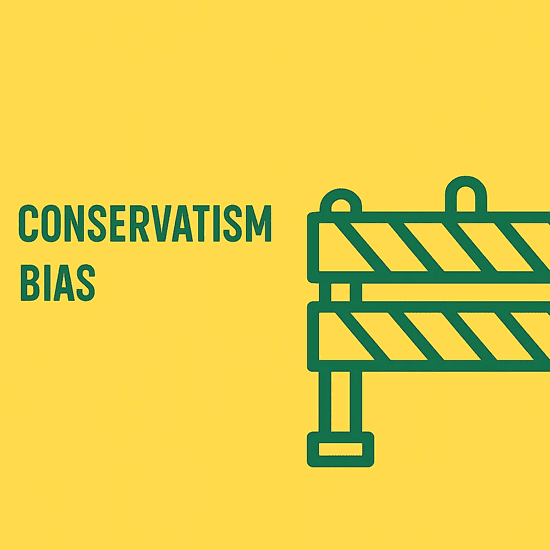October 3, 2025 – In the fast-paced world of financial markets, cognitive biases can significantly influence investment decisions, often leading to suboptimal outcomes. Today’s Word of the Day, Conservatism Bias, highlights a common psychological tendency that affects how investors process new information and make choices. This article explores the concept, provides real-world examples, and explains its implications for traders and investors, offering insights to help navigate this mental trap.
What is Conservatism Bias?
Conservatism bias refers to the tendency of individuals to cling to prior beliefs or existing information, even when new, compelling evidence suggests a need to update those views. In financial contexts, this bias manifests as a reluctance to fully incorporate new data into investment decisions, leading to sluggish adjustments in expectations or portfolios. Investors under the influence of conservatism bias often overweight their original assumptions and underreact to fresh market signals, which can result in missed opportunities or prolonged exposure to losing positions.
This bias stems from the human inclination to seek comfort in familiarity and resist change, especially when new information challenges established strategies or worldviews. Unlike confirmation bias, where people actively seek data to support existing beliefs, conservatism bias involves a passive resistance to updating beliefs in light of new evidence. In markets, this can lead to delayed reactions to critical economic indicators, corporate earnings reports, or geopolitical events.
Examples of Conservatism Bias in Investing
To illustrate how conservatism bias plays out, consider the following scenarios:
- Sticking to a Declining Stock An investor holds shares in a retail company that has been a long-time favorite due to its strong historical performance. Despite recent earnings reports showing declining sales and increased competition from e-commerce giants, the investor clings to the belief that the company will rebound based on its past success. They fail to adjust their portfolio, ignoring new data about shifting consumer trends, and continue holding the stock as it loses value. This reluctance to act on fresh evidence exemplifies conservatism bias.
- Underreacting to Macroeconomic Shifts In early 2025, a trader maintains a bullish outlook on oil stocks, anchored in the belief that global demand will remain robust. However, new reports indicate a significant push toward renewable energy adoption and declining oil consumption in key markets. Instead of revising their strategy to account for these structural changes, the trader only makes minor adjustments, convinced that oil’s historical dominance will persist. This slow response to transformative data reflects conservatism bias.
- Ignoring Analyst Upgrades An investor owns a tech stock that has underperformed for months. Recently, multiple analysts upgraded the stock’s rating based on improved earnings forecasts and innovative product launches. However, the investor, anchored to their initial skepticism about the company’s turnaround potential, dismisses the upgrades as overly optimistic. By failing to act on this new positive information, they miss out on a potential rally, showcasing conservatism bias.
Implications and How to Mitigate Conservatism Bias
Conservatism bias can lead to costly mistakes, such as holding onto losing investments too long or missing out on emerging opportunities. In volatile markets, where timely decisions are critical, this bias can amplify losses or cap gains. For instance, during the Asian market session on October 2, 2025, the KOSPI surged 2.70% due to strong domestic demand and real estate recovery in South Korea. An investor with conservatism bias, anchored to a bearish view of the region, might have hesitated to capitalize on this rally, missing significant gains.
To counteract conservatism bias, investors can adopt the following strategies:
- Actively Seek Diverse Data: Regularly review a broad range of sources, such as economic reports, analyst ratings, and market news, to challenge existing assumptions.
- Set Clear Decision Rules: Establish predefined criteria for adjusting positions (e.g., sell if a stock drops 10% or buy if earnings exceed forecasts by a certain margin) to reduce emotional attachment to prior beliefs.
- Leverage Technology: Use algorithmic tools or portfolio management software to flag significant changes in market conditions, prompting quicker reassessments.
- Consult Peers or Advisors: Engage with financial advisors or trading communities, like those at the upcoming Africa Trading Conference 2025, to gain fresh perspectives and challenge entrenched views.
Conclusion
Conservatism bias is a subtle but pervasive obstacle in financial decision-making, anchoring investors to outdated beliefs and slowing their response to new market realities. By recognizing this bias and proactively seeking diverse inputs, investors can make more agile and informed decisions, better aligning their portfolios with current opportunities. Awareness is the first step to overcoming this cognitive hurdle, ensuring that new evidence drives action rather than being sidelined by the comfort of the familiar.
Disclaimer The content on MarketsFN.com is provided for educational and informational purposes only. It does not constitute financial advice, investment recommendations, or trading guidance. All investments involve risks, and past performance does not guarantee future results. You are solely responsible for your investment decisions and should conduct independent research and consult a qualified financial advisor before acting. MarketsFN.com and its authors are not liable for any losses or damages arising from your use of this information.
